An Easy-Implemented On-Chip Waveguide Coupled Single Photon Source Based on Self-Assembled Quantum Dots Membrane
Abstract
Featured Application
Abstract
1. Introduction
2. Design and Method
2.1. Design
2.2. Materials
2.3. Optical Setup
3. Results and Discussion
3.1. Photoluminescence Spectra
3.2. Single-Photon Nature
4. Discussion
5. Conclusions
6. Patents
Author Contributions
Funding
Data Availability Statement
Acknowledgments
Conflicts of Interest
References
- Knill, E.; Laflamme, R.; Milburn, G.J. A scheme for efficient quantum computation with linear optics. Nature 2001, 409, 46–52. [Google Scholar] [CrossRef] [PubMed]
- O’brien, J.L. Optical quantum computing. Science 2007, 318, 1567–1570. [Google Scholar] [CrossRef] [PubMed]
- O’brien, J.L.; Furusawa, A.; Vučković, J. Photonic quantum technologies. Nat. Photonics 2009, 3, 687–695. [Google Scholar] [CrossRef]
- Kennard, J.E.; Hadden, J.P.; Marseglia, L.; Aharonovich, I.; Castelletto, S.; Patton, B.R.; Politi, A.; Matthews, J.C.F.; Sinclair, A.G.; Gibson, B.C.; et al. On-chip manipulation of single photons from a diamond defect. Phys. Rev. Lett. 2013, 111, 213603. [Google Scholar] [CrossRef] [PubMed]
- Schwagmann, A.; Kalliakos, S.; Farrer, I.; Griffiths, J.P.; Jones, G.A.; Ritchie, D.A.; Shields, A.J. On-chip single photon emission from an integrated semiconductor quantum dot into a photonic crystal waveguide. Appl. Phys. Lett. 2011, 99, 261108. [Google Scholar] [CrossRef]
- Tonndorf, P.; Del Pozo-Zamudio, O.; Gruhler, N.; Kern, J.; Schmidt, R.; Dmitriev, A.I.; Bratschitsch, R. On-chip waveguide coupling of a layered semiconductor single-photon source. Nano Lett. 2017, 17, 5446–5451. [Google Scholar] [CrossRef]
- Khasminskaya, S.; Pyatkov, F.; Słowik, K.; Ferrari, S.; Kahl, O.; Kovalyuk, V.; Rath, P.; Vetter, A.; Hennrich, F.; Kappes, M.M.; et al. Fully integrated quantum photonic circuit with an electrically driven light source. Nat. Photonics 2016, 10, 727–732. [Google Scholar] [CrossRef]
- Rengstl, U.; Schwartz, M.; Herzog, T.; Hargart, F.; Paul, M.; Portalupi, S.L.; Jetter, M.; Michler, P. On-chip beamsplitter operation on single photons from quasi-resonantly excited quantum dots embedded in GaAs rib waveguides. Appl. Phys. Lett. 2015, 107, 021101. [Google Scholar] [CrossRef]
- Senellart, P.; Solomon, G.; White, A. High-performance semiconductor quantum-dot single-photon sources. Nat. Nanotechnol. 2017, 12, 1026. [Google Scholar] [CrossRef]
- Gazzano, O.; Michaelis de Vasconcellos, S.; Arnold, C.; Nowak, A.; Galopin, E.; Sagnes, I.; Lanco, L.; Lemaitre, A.; Senellart, P. Bright solid-state sources of indistinguishable single photons. Nat. Commun. 2013, 4, 1–6. [Google Scholar] [CrossRef]
- Dousse, A.; Suffczynski, J.; Beveratos, A.; Krebs, O.; Lemaitre, A.; Sagnes, I.; Bloch, J.; Voisin, P.; Senellart, P. Ultrabright source of entangled photon pairs. Nature 2010, 466, 217–220. [Google Scholar] [CrossRef] [PubMed]
- Kim, J.H.; Aghaeimeibodi, S.; Richardson, C.J.K.; Leavitt, R.P.; Englund, D.; Waks, E. Hybrid integration of solid-state quantum emitters on a silicon photonic chip. Nano Lett. 2017, 17, 7394–7400. [Google Scholar] [CrossRef] [PubMed]
- Davanco, M.; Liu, J.; Sapienza, L.; Zhang, C.Z.; De Miranda Cardoso, J.V.; Verma, V.; Mirin, R.; Nam, S.W.; Liu, L.; Srinivasan, K. Heterogeneous integration for on-chip quantum photonic circuits with single quantum dot devices. Nat. Commun. 2017, 8, 889. [Google Scholar] [CrossRef] [PubMed]
- Elshaari, A.W.; Zadeh, I.E.; Fognini, A.; Reimer, M.E.; Dalacu, D.; Poole, P.J.; Zwiller, V.; Jons, K.D. On-chip single photon filtering and multiplexing in hybrid quantum photonic circuits. Nat. Commun. 2017, 8, 379. [Google Scholar] [CrossRef] [PubMed]
- Aghaeimeibodi, S.; Desiatov, B.; Kim, J.H.; Lee, C.M.; Buyukkaya, M.A.; Karasahin, A.; Richardson, C.J.K.; Leavitt, R.P.; Loncar, M.; Waks, E. Integration of quantum dots with lithium niobate photonics. Appl. Phys. Lett. 2018, 113, 221102. [Google Scholar] [CrossRef]
- Cardenas, J.; Poitras, C.B.; Luke, K.; Luo, L.W.; Morton, P.A.; Lipson, M. High coupling efficiency etched facet tapers in silicon waveguides. IEEE Photonics Technol. Lett. 2014, 26, 2380–2382. [Google Scholar] [CrossRef]
- Ates, S.; Agha, I.; Gulinatti, A.; Rech, I.; Badolato, A.; Srinivasan, K. Improving the performance of bright quantum dot single photon sources using temporal filtering via amplitude modulation. Sci. Rep. 2013, 3, 1397. [Google Scholar] [CrossRef]
- Dolores-Calzadilla, V.; Romeira, B.; Pagliano, F.; Birindelli, S.; Higuera-Rodriguez, A.; Van Veldhoven, P.J.; Smit, M.K.; Fiore, A.; Heiss, D. Waveguide-coupled nanopillar metal-cavity light-emitting diodes on silicon. Nat. Commun. 2017, 8, 1–8. [Google Scholar]
- Makhonin, M.N.; Dixon, J.E.; Coles, R.J.; Royall, B.; Luxmoore, I.J.; Clarke, E.; Hugues, M.; Skolnick, M.S.; Fox, A.M. Waveguide coupled resonance fluorescence from on-chip quantum emitter. Nano Lett. 2014, 14, 6997–7002. [Google Scholar] [CrossRef]
- Prtljaga, N.; Coles, R.J.; O’Hara, J.; Royall, B.; Clarke, E.; Fox, A.M.; Skolnick, M.S. Monolithic integration of a quantum emitter with a compact on-chip beam-splitter. Appl. Phys. Lett. 2014, 104, 231107. [Google Scholar] [CrossRef]
- Prtljaga, N.; Bentham, C.; O’Hara, J.; Royall, B.; Clarke, E.; Wilson, L.R.; Skolnick, M.S.; Fox, A.M. On-chip interference of single photons from an embedded quantum dot and an external laser. Appl. Phys. Lett. 2016, 108, 251101. [Google Scholar] [CrossRef]
- Schnauber, P.; Schall, J.; Bounouar, S.; Höhne, T.; Park, S.I.; Ryu, G.H.; Heindel, T.; Burger, S.; Song, J.D.; Rodt, S.; et al. Deterministic integration of quantum dots into on-chip multimode interference beamsplitters using in situ electron beam lithography. Nano Lett. 2018, 18, 2336–2342. [Google Scholar] [CrossRef] [PubMed]
- Mrowinński, P.; Schnauber, P.; Gutsche, P.; Kaganskiy, A.; Schall, J.; Burger, S.; Rodt, S.; Reitzenstein, S. Directional emission of a deterministically fabricated quantum dot–bragg reflection multimode waveguide system. ACS Photonics 2019, 6, 2231–2237. [Google Scholar] [CrossRef]
- Dusanowski, Ł.; Köck, D.; Shin, E.; Kwon, S.H.; Schneider, C.; Höfling, S. Purcell-enhanced and indistinguishable single-photon generation from quantum dots coupled to on-chip integrated ring resonators. Nano Lett. 2020, 20, 6357–6363. [Google Scholar] [CrossRef]
- Faraon, A.; Fushman, I.; Englund, D.; Stoltz, N.; Petroff, P.; Vučković, J. Dipole induced transparency in waveguide coupled photonic crystal cavities. Opt. Express 2008, 16, 12154–12162. [Google Scholar] [CrossRef]
- Bentham, C.; Hallett, D.; Prtljaga, N.; Royall, B.; Vaitiekus, D.; Coles, R.J.; Clarke, E.; Fox, A.M.; Skolnick, M.S.; Itskevich, I.E.; et al. Single-photon electroluminescence for on-chip quantum networks. Appl. Phys. Lett. 2016, 109, 161101. [Google Scholar] [CrossRef]
- Huo, Y.H.; Witek, B.J.; Kumar, S.; Cardenas, J.R.; Zhang, J.X.; Akopian, N.; Singh, R.; Zallo, E.; Grifone, R.; Kriegner, D.; et al. A light-hole exciton in a quantum dot. Nat. Phys. 2014, 10, 46–51. [Google Scholar] [CrossRef]
- Huo, Y.H.; Rastelli, A.; Schmidt, O.G. Ultra-small excitonic fine structure splitting in highly symmetric quantum dots on GaAs (001) substrate. Appl. Phys. Lett. 2013, 102, 152105. [Google Scholar] [CrossRef]
- Aspnes, D.E.; Kelso, S.M.; Logan, R.A.; Bhat, R. Optical properties of AlxGa1− xAs. J. Appl. Phys. 1986, 60, 754–767. [Google Scholar] [CrossRef]
- Basché, T.; Moerner, W.E.; Orrit, M.; Talon, H. Photon antibunching in the fluorescence of a single dye molecule trapped in a solid. Phys. Rev. Lett. 1992, 69, 1516. [Google Scholar] [CrossRef]
- Dietrich, C.P.; Fiore, A.; Thompson, M.G.; Kamp, M.; Höfling, S. GaAs integrated quantum photonics: Towards compact and multi-functional quantum photonic integrated circuits. Laser Photonics Rev. 2016, 10, 870–894. [Google Scholar] [CrossRef]
- Murray, E.; Ellis, D.J.P.; Meany, T.; Floether, F.F.; Lee, J.P.; Griffiths, J.P.; Jones, G.A.C.; Farrer, I.; Ritchie, D.A.; Bennett, A.J.; et al. Quantum photonics hybrid integration platform. Appl. Phys. Lett. 2015, 107, 171108. [Google Scholar] [CrossRef]
- Wan, N.H.; Lu, T.J.; Chen, K.C.; Walsh, M.P.; Trusheim, M.E.; De Santis, L.; Bersin, E.A.; Harris, I.B.; Mouradian, S.L.; Christen, I.R.; et al. Large-scale integration of artificial atoms in hybrid photonic circuits. Nature 2020, 583, 226–231. [Google Scholar] [CrossRef]
- Lukin, D.M.; Dory, C.; Guidry, M.A.; Yang, K.Y.; Mishra, S.D.; Trivedi, R.; Radulaski, M.; Sun, S.; Vercruysse, D.; Ahn, G.H.; et al. 4H-silicon-carbide-on-insulator for integrated quantum and nonlinear photonics. Nat. Photonics 2020, 14, 330–334. [Google Scholar] [CrossRef]
- Vogel, M.M.; Ulrich, S.M.; Hafenbrak, R.; Michler, P.; Wang, L.; Rastelli, A.; Schmidt, O.G. Influence of lateral electric fields on multiexcitonic transitions and fine structure of single quantum dots. Appl. Phys. Lett. 2007, 91, 051904. [Google Scholar] [CrossRef]
- Gerardot, B.D.; Seidl, S.; Dalgarno, P.A.; Warburton, R.J.; Granados, D.; Garcia, J.M.; Kowalik, K.; Krebs, O.; Karrai, K.; Badolato, A.; et al. Manipulating exciton fine structure in quantum dots with a lateral electric field. Appl. Phys. Lett. 2007, 90, 041101. [Google Scholar] [CrossRef]
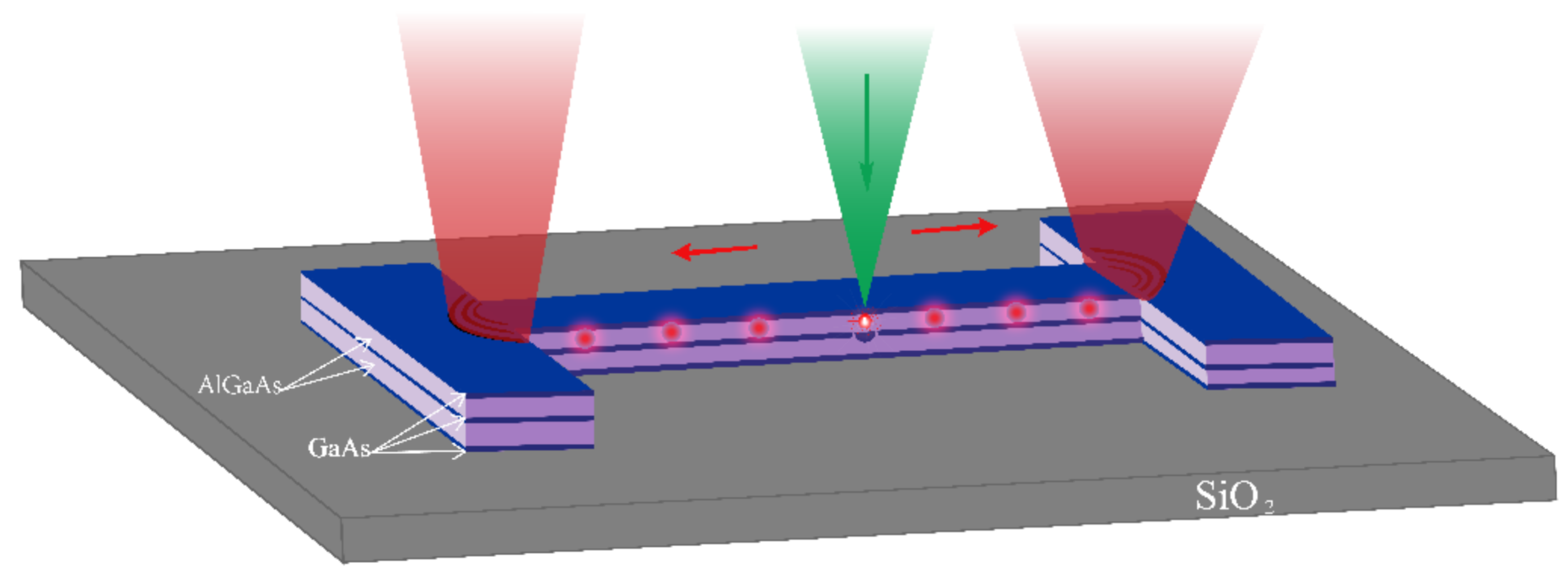
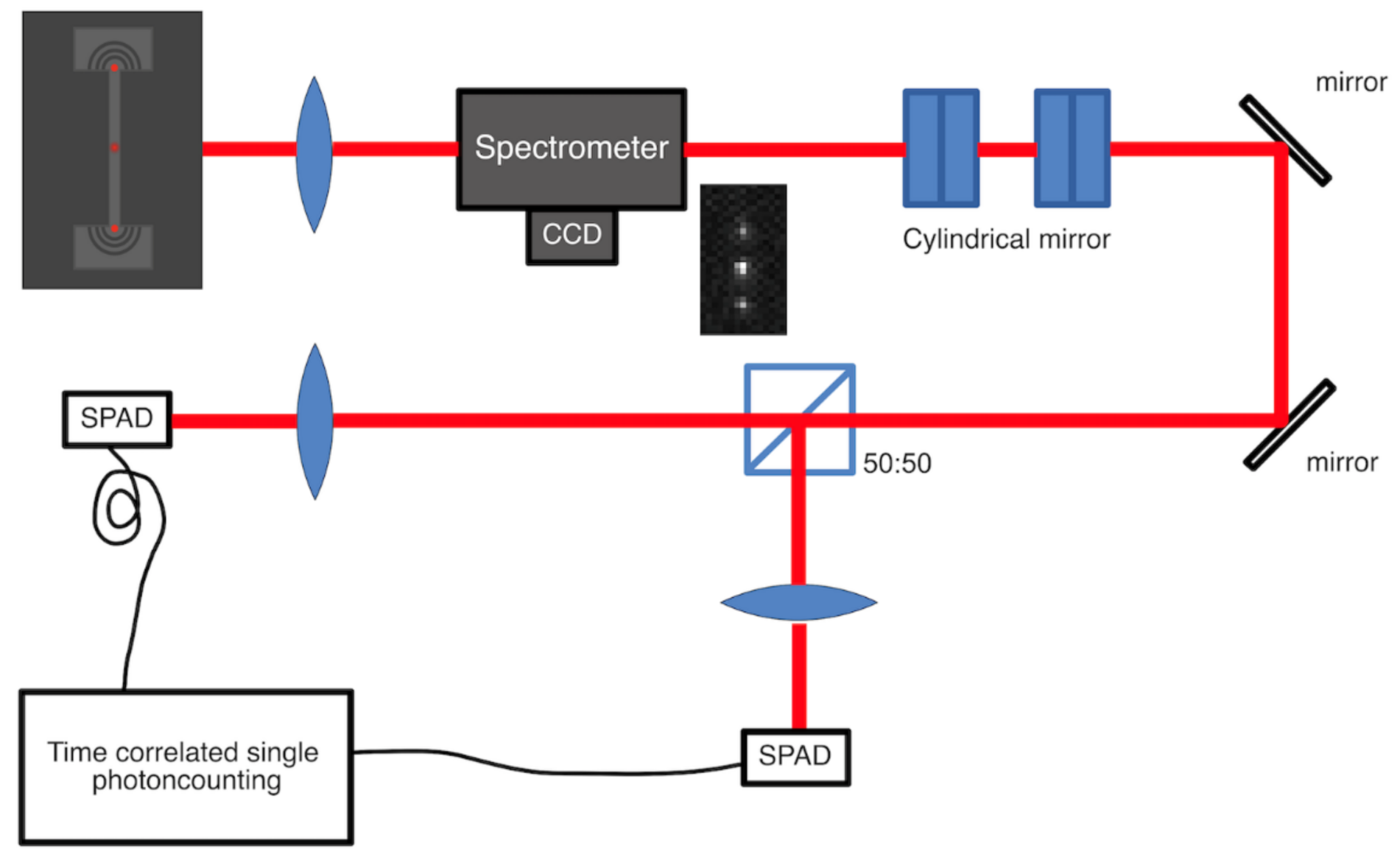
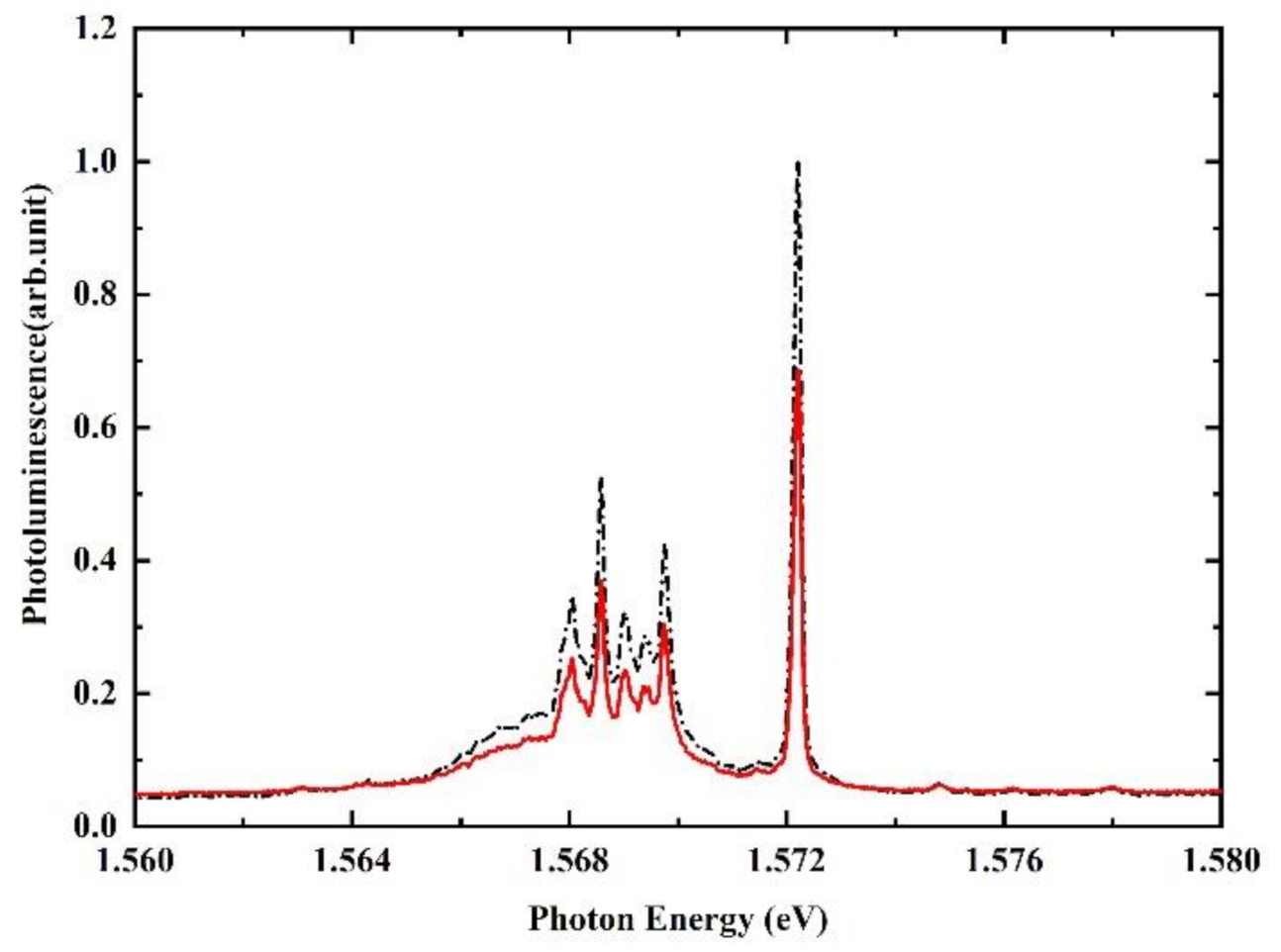
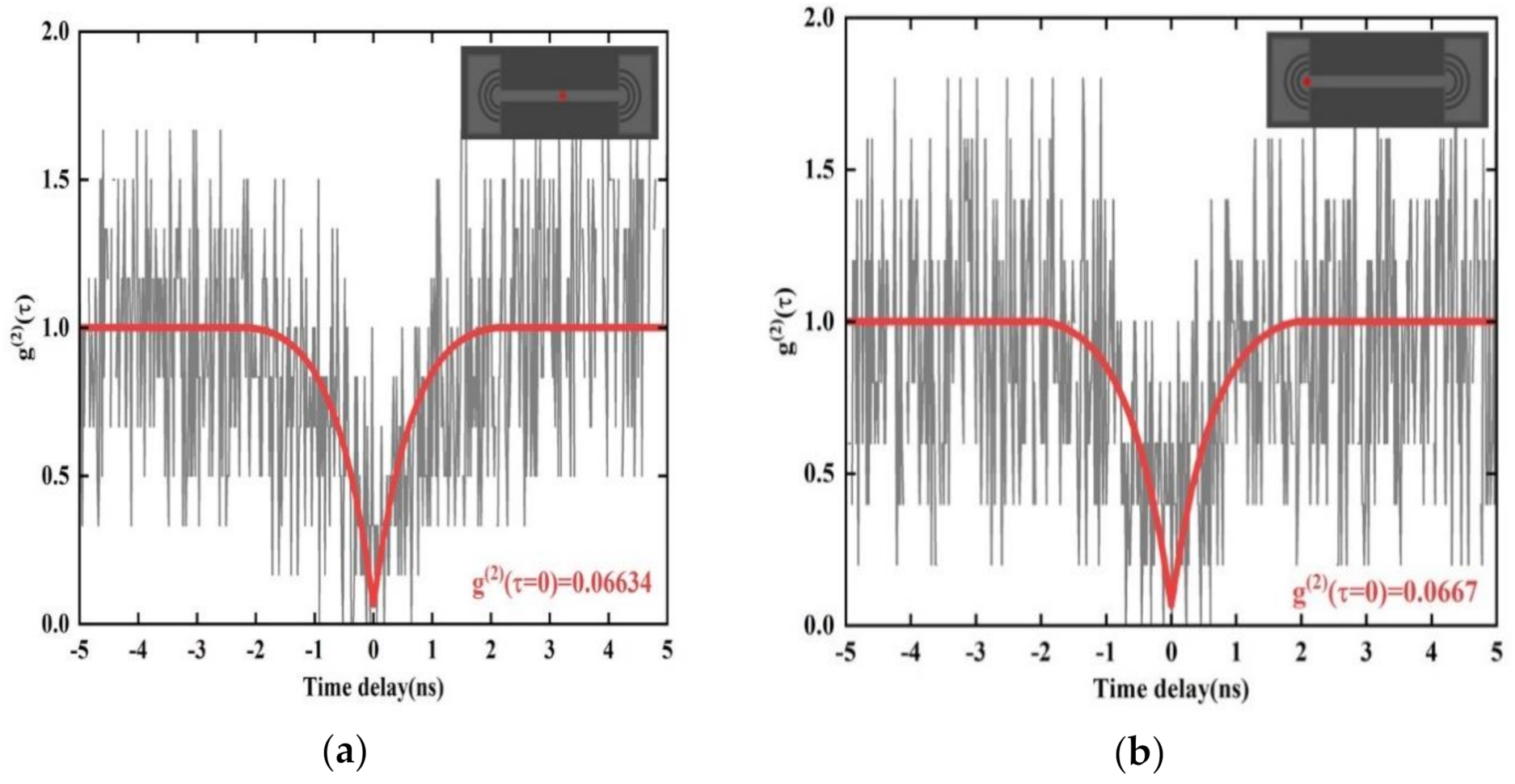
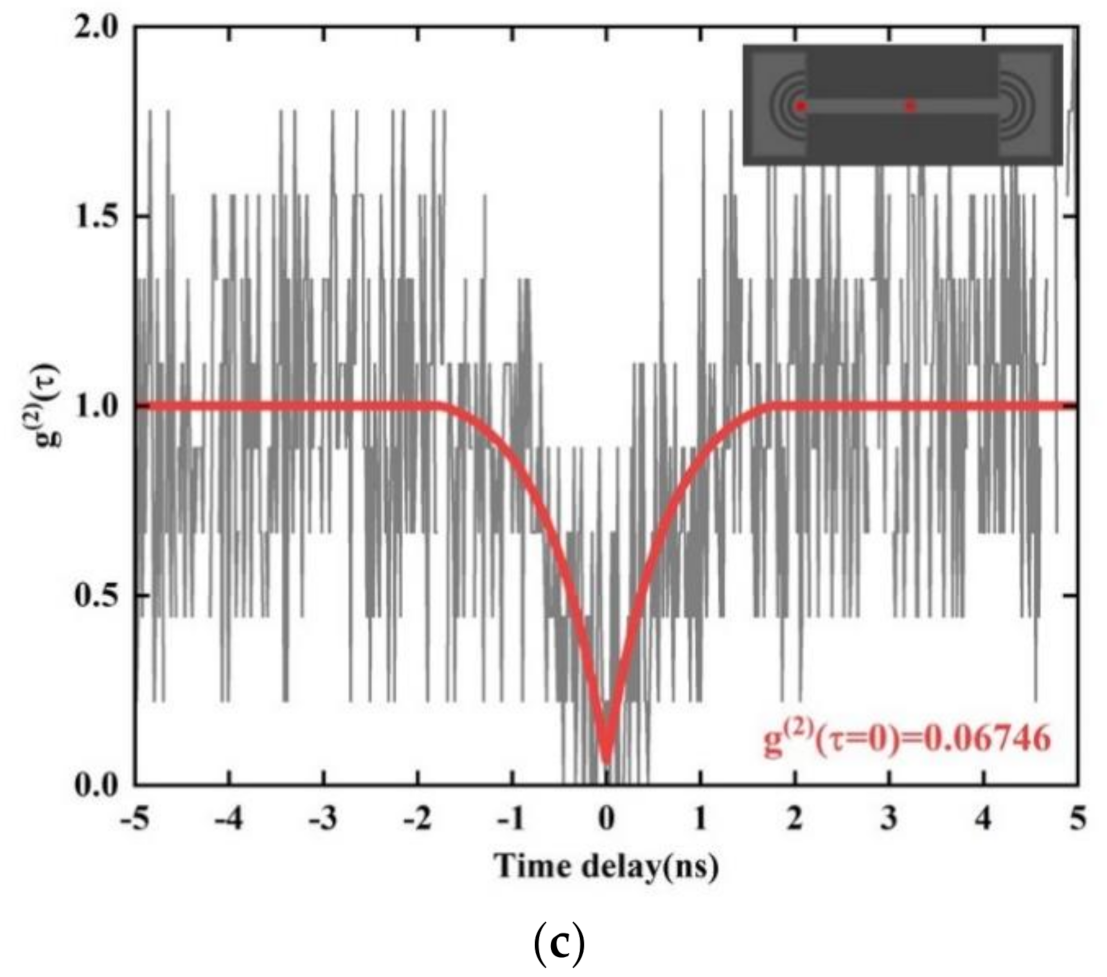
Publisher’s Note: MDPI stays neutral with regard to jurisdictional claims in published maps and institutional affiliations. |
© 2021 by the authors. Licensee MDPI, Basel, Switzerland. This article is an open access article distributed under the terms and conditions of the Creative Commons Attribution (CC BY) license (http://creativecommons.org/licenses/by/4.0/).
Share and Cite
Jiang, P.; Ma, N.; Liu, P.; Wu, W.; Zhang, K. An Easy-Implemented On-Chip Waveguide Coupled Single Photon Source Based on Self-Assembled Quantum Dots Membrane. Appl. Sci. 2021, 11, 695. https://doi.org/10.3390/app11020695
Jiang P, Ma N, Liu P, Wu W, Zhang K. An Easy-Implemented On-Chip Waveguide Coupled Single Photon Source Based on Self-Assembled Quantum Dots Membrane. Applied Sciences. 2021; 11(2):695. https://doi.org/10.3390/app11020695
Chicago/Turabian StyleJiang, Ping, Na Ma, Peng Liu, Wenxuan Wu, and Kai Zhang. 2021. "An Easy-Implemented On-Chip Waveguide Coupled Single Photon Source Based on Self-Assembled Quantum Dots Membrane" Applied Sciences 11, no. 2: 695. https://doi.org/10.3390/app11020695
APA StyleJiang, P., Ma, N., Liu, P., Wu, W., & Zhang, K. (2021). An Easy-Implemented On-Chip Waveguide Coupled Single Photon Source Based on Self-Assembled Quantum Dots Membrane. Applied Sciences, 11(2), 695. https://doi.org/10.3390/app11020695




